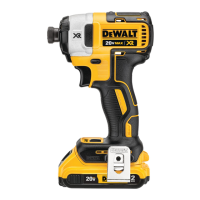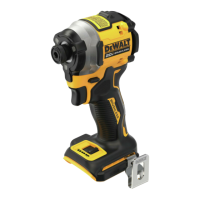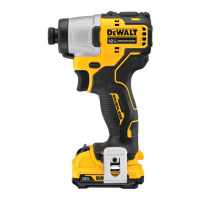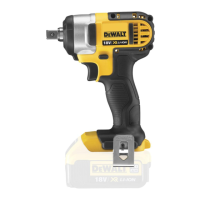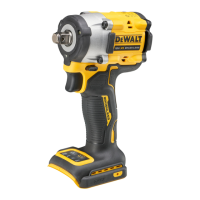11
ENGLISH
Precision Wrench™ (Fig. C)
In addition to low speed impacting modes, this tool features
the Precision Wrench™ mode which grants the user greater
control in both fastening and loosening applications. When set
in forward, the tool will fasten at 2000RPM until impact begins.
The tool will then pause for 0.5 seconds before continuing
to impact at a rate of 3250IPM, providing the user with
greater control and reducing the chance of overtightening or
damagingmaterial.
When set in reverse, the tool will impact at a normal speed and
rate of 3250IPM. Upon sensing that the fastener has broken
free, the tool will cease to impact and will reduce speed to help
prevent “run‑off” of loosehardware.
Specifications
Mode Application RPM
Low Mode Normal Impacting 0–600 forward
0–2000 reverse
Medium Mode Medium Impacting 0–1200 forward
0–2000 reverse
High Mode High Speed Impacting 0–2000 forward
0–2000 reverse
Precision Wrench™ Mode Precision Wrench™ 0–2000 forward
0–2000 reverse
Mode Selector (Fig. A, C)
Your tool is equipped with a mode selector
7
which allows you
to select one of three speeds or Precision Wrench™ mode. Select
the mode based on the maximum speed/torque needed and
control the speed of the tool using the variable speed trigger
switch
1
.
Worklight (Fig. A, C)
The worklight
6
is activated when the variable speed trigger
1
is depressed. Pressing the worklight switch
15
repeatedly will
cycle through low illumination, high illumination, andoff.
NOTE: The worklight is for lighting the immediate work surface
and is not intended to be used as aflashlight.
Usage (Fig. A)
CAUTION: Ensure fastener and/or system will withstand
the level of torque generated by the tool. Excessive torque
may cause breakage and possible personalinjury.
1. Place the accessory on the fastener head. Keep the tool
pointed straight at thefastener.
2. Press variable speed trigger switch
1
to start operation.
Release variable speed trigger switch to stop operation.
Always check torque with a torque wrench, as the fastening
torque is affected by many factors including the following:
‑ Voltage: Low voltage, due to a nearly discharged
battery, will reduce fasteningtorque.
‑ Accessory size: Failure to use the correct accessory size
will cause a reduction in fasteningtorque.
‑ Bolt size: Larger bolt diameters generally require
higher fastening torque. Fastening torque will also vary
according to length, grade, and torquecoefficient.
‑ Bolt: Ensure that all threads are free of rust and other
debris to allow proper fasteningtorque.
‑ Material: The type of material and surface finish of the
material will affect fasteningtorque.
Proper Hand Position (Fig. E)
WARNING: To reduce the risk of serious personal injury,
ALWAYS use proper hand position asshown.
WARNING: To reduce the risk of serious personal
injury, ALWAYS hold securely in anticipation of a
suddenreaction.
Proper hand position requires one hand on the main
handle
10
.
OPERATION
Instructions for Use
WARNING: Always observe the safety instructions and
applicableregulations.
WARNING: To reduce the risk of serious personal
injury, turn tool off and disconnect battery pack
before making any adjustments or removing/
installing attachments or accessories. An accidental
start‑up can causeinjury.
Depression of detent pin may be necessary to aid installation
ofaccessory.
To remove an accessory, depress the detent pin through the
hole and pull the accessoryoff.
Anvil With Hog Ring (Fig.D)
DCF891
To install an accessory on the hog ring anvil, firmly push
accessory onto the anvil
3
. The hog ring
13
compresses to
allow the accessory to slide on. After accessory is installed, the
hog ring applies pressure to help provide accessoryretention.
To remove an accessory, grasp the accessory and firmly pull
itoff.
Anvil (Fig. A)
WARNING: Use only impact accessories. Non‑impact
accessories may break and cause a hazardous condition.
Inspect accessory prior to use to ensure that it contains
nocracks.
CAUTION: Inspect anvils, detent pins, and hog rings prior
to use. Missing or damaged items should be replaced
beforeuse.
Place the switch in the locked off (centre) position or remove
battery pack before changingaccessories.
Anvil with Detent Pin (Fig.D)
DCF892
To install an accessory on the anvil, align the hole in the side
of the accessory with the detent pin
14
on the anvil
3
. Press
the accessory on until the detent pin engages in the hole.
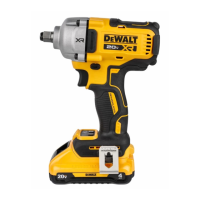
